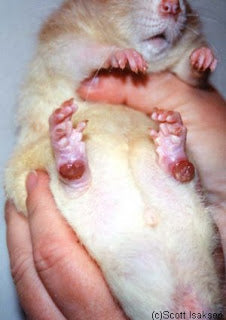Bumblefoot Prevention |

Photo credits: http://ratguide.com/health/ | Okay, so this topic came up while I was prowling my fave rat forum. I see more and more post about people worried about their rats getting bumblefoot from uncovered wire mesh cages. Apparently, mesh wire cages are under a huge debate...to cover or not to cover. That is the question. This is my take on the subject. :) Bumblefoot, or ulcerative pododermatitis, is the inflammation and infection of the plantar surface and connective tissue of the foot/feet. Bumblefoot is usually genetic, or found most commonly in older, overweight rats, or in rats that have been living in unsanitary conditions. |
| Today's pet cages, or at least most of them, are powder-coated galvanized steel.I would also say a rat would be at a higher risk for bumblefoot if it was walking around on uncoated galvanized steel. It's much harder on the feet and since its uncoated, it can cause tiny hairline cuts into the rats feet- and since rats like to pee/poo on everything, that bacteria can get into those cuts and cause infections. Test it out for yourself: place your palm on a powder coated mesh cage shelf or floor and the other palm on uncoated mesh (such as hardware cloth/ chicken wire). Put all your weight on your hands, as if doing a push up. The uncoated steel will cut into your hand, it may not break the skin, but it is certainly uncomfortable. That's how your ratties feel walking on it day in and day out. Now imagine rough-housing or racing up and down on that same rough wire mesh...you would likely get teeny tiny cuts.....get the picture? So here is what I suggest to prevent bumblefoot: 1. Buy a powder coated cage- such as a cage marketed for small animals...if you decide to do a homemade cage, be sure to pay close attention to covering any hardware cloth mesh. There are even some companies that will powder coat hardware cloth for you. Check around. 2. Even with a powder coated cage, be sure to provide lots of soft bedding so your rats can "get off their feet". Hammocks and solid floored areas are perfect for this. Bumblefoot is like bed sores, and even rats kept on solid hard floors can get it. So give them something comfy to walk on too. 3. Keep your cage clean- including wiping down all shelves and floors at least every other day. I use baby wipes for this. It also helps keep the smell down. Change bedding often and litter box train your rats. Getting them to elimate in one place helps. 4. Do a daily health check on your rats- not only looking for signs of foot irritations but also checking breathing, skin, fur, etc. Its just a good habit to do, so when and if your rats ever develop a problem or get sick, you can catch it early. I plan on doing a post here on my blog about daily health checks in the near future, so be sure to check back! If you do notice any irritation on the feet, be sure to set up an appointment with your vet right away to get it checked out. 5. Keep your rats slim and trim! A fat squishy rat is certainly cuddly, but the health problems that can come from being overweight, including bumblefoot, isn't worth it. Also keep their nails trimmed as rats with long nails are more prone to put more weight on the heels. 6. When at all possible, if you are not adopting a rescue rat, try to purchase your rats from reputable breeders. This helps with the genetic aspect. To learn more about bumblefoot, including recommended treatment, please visit: http://ratguide.com/health/integumentary_skin/ulcerative_pododermatitis.php |





